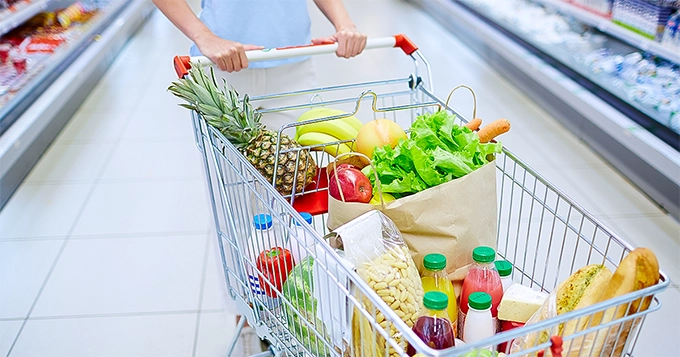Healthy grocery shopping, or just grocery shopping in general, can be challenging, especially since everything is expensive these days!
But don’t let it stop you from having a healthy and inexpensive pantry stock. You’re more likely to purchase healthier goods, save time, and stay within your budget if you go to the market prepared with a healthy grocery list on a budget and if you follow these tips.
Create a Healthy Grocery Shopping List
You have two primary methods at your disposal: the digital route or the traditional pen-and-paper approach. Clearly, one of these options will serve you better. If you go for the digital route and create a grocery list on your smartphone, you will always have access to it (let’s face it, when was the last time you went anywhere without your phone?). This eliminates the risk of leaving your paper list behind at home, at work, or in the car.
Begin by reviewing your master list, noting which items are running low and which you have plenty of. Then, compose a list of items you don’t have at all.
Also, make sure you include vegetables, fruits, grains, dairy or dairy substitutes, nuts, and seeds to have a healthy pantry stock.
Your healthy grocery list can include the following items:
- Fruits: apples, grapefruits, clementines, blueberries, and avocados
- Non-starchy Vegetables: asparagus, broccoli, spinach, onions, peppers, and zucchini
- Starchy Vegetables: baby red potatoes, sweet potatoes, and butternut squash
- Beans and Grains: brown rice, wild rice, chickpeas, black beans, and quinoa
- Proteins: eggs, canned salmon, chicken breast, and pea protein powder
- Frozen Foods: frozen kale and frozen mixed berries
- Nuts and Seeds: pumpkin seeds, natural peanut butter, chia seeds and roasted almonds
- Dairy and Non-dairy Substitutes: cashew milk, feta cheese, coconut milk, and full-fat Greek yogurt
- Condiments: olives, salad dressing, sun-dried tomatoes, pesto, olive oil, and salsa
- Drinks: sparkling water and unsweetened coconut water
- Miscellaneous: dried fruit, round coffee, banana plantain chips, dark chocolate, and shredded unsweetened coconut
Plan Your Weekly Menu
Alternatively, you can bring a weekly meal plan to the store instead of a normal grocery list. This menu should outline the ingredients required to prepare the meals you intend to cook in the upcoming week.
For instance, if you’re enthusiastic about meal prep, consider printing out the recipes you plan to follow and then shop based on these ingredient lists.
Keep in mind that if you’re accustomed to dining out or ordering in frequently, transitioning to preparing all your meals and snacks at home may not be immediately feasible. Therefore, if you’re new to meal prep, initiate the process gradually by starting with just a few meals during the first week. As it becomes a routine, gradually expand your repertoire.
Like any healthy habit, it might take some time before grocery shopping and cooking nutritious meals at home become second nature.
Shop the Outer Aisles of the Store First
Initiate your shopping by exploring the store’s outer aisles. This is where you’ll encounter fresh foods like vegetables, fruits, whole grains, dairy, fish, and lean meats. Proceed to the center aisles to source healthy staples such as frozen fruits and vegetables, canned or dry beans, and instant oatmeal.
Shop on a Full Stomach
Going on a grocery shopping trip while hungry is not advised. Hunger can lead to impulsive purchases driven by temporary cravings rather than a thoughtful consideration of nutritional content, leaving you yearning for more later.
Read Nutrition Facts Labels
Packaging doesn’t inherently imply a lack of healthiness. Nevertheless, it’s prudent to scrutinize ingredient labels and assess the nutrition facts of packaged items.
Understanding the Nutrition Facts label simplifies the process of making healthier choices. The label delineates calorie content, carbohydrate, fat, fiber, protein, and vitamin levels per serving, facilitating comparisons between similar products.
It also highlights key nutrients with implications for health. Use this label to align with your specific dietary needs, aiming for foods rich in the nutrients you wish to increase and low in those you wish to limit.
Buying Frozen or Canned Fruits and Veggies Helps Avoid Food Waste.
It is better to buy fresh produce because they are … well, fresh. But they do go bad easily, and you might tend to have more food waste. Canned fruits and veggies tend to have a longer shelf life.
When selecting canned vegetables, prioritize options labeled “no salt added” or “lower sodium.” Similarly, opt for frozen vegetables without sauces, seasonings, or added salt. Before using canned vegetables or beans, be sure to drain and rinse them to reduce excess sodium. When choosing canned fruits, opt for those canned in water or natural juice or labeled as having no added sugar – buy frozen fruit without syrups, added sugars, or sweeteners.
Choose “Whole-Grain” Grains and Bread
Whole-grain foods are excellent choices for a nutritious diet, as they provide essential fiber, vitamins, minerals, and other nutrients. They contribute to cholesterol control, weight management, and blood pressure regulation while also reducing the risk of diabetes, heart disease, and other health issues.
Choose No Salt Or Lower-Sodium Canned Fish, Chicken, Or Lean Meat.
Canned fish, chicken, and meat often contain high levels of salt, which isn’t ideal for optimal health. Seek products packaged in water instead of oil, and make sure your canned goods are labeled with “no salt added” or “lower sodium.”
Check Off Items as You Shop
To stay organized and avoid duplications, mark items off your list as you place them in your cart. Utilize checkmarks, strikethroughs, or a color-coded system to maintain order during your shopping excursion.









